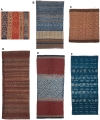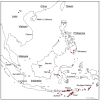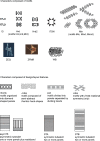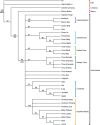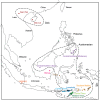Investigating cultural evolution using phylogenetic analysis: the origins and descent of the southeast Asian tradition of warp ikat weaving - PubMed (original) (raw)
Investigating cultural evolution using phylogenetic analysis: the origins and descent of the southeast Asian tradition of warp ikat weaving
Christopher D Buckley. PLoS One. 2012.
Abstract
The warp ikat method of making decorated textiles is one of the most geographically widespread in southeast Asia, being used by Austronesian peoples in Indonesia, Malaysia and the Philippines, and Daic peoples on the Asian mainland. In this study a dataset consisting of the decorative characters of 36 of these warp ikat weaving traditions is investigated using Bayesian and Neighbornet techniques, and the results are used to construct a phylogenetic tree and taxonomy for warp ikat weaving in southeast Asia. The results and analysis show that these diverse traditions have a common ancestor amongst neolithic cultures the Asian mainland, and parallels exist between the patterns of textile weaving descent and linguistic phylogeny for the Austronesian group. Ancestral state analysis is used to reconstruct some of the features of the ancestral weaving tradition. The widely held theory that weaving motifs originated in the late Bronze Age Dong-Son culture is shown to be inconsistent with the data.
Conflict of interest statement
Competing Interests: The author declares that no competing interests exist.
Figures
Figure 1. The warp ikat process: making the resists.
Warp threads stretched on a frame, with partly tied ikat resists, on the island of Alor. Weavers use essentially the same method, using a similar frame, in all the areas considered in this study.
Figure 2. The warp ikat process: weaving.
Sketch showing how a backstrap loom is used by weavers on Hainan Island to weave ikat cloth. Weavers use similar backstrap looms in all the areas considered in this study, though in most areas outside of Hainan weavers attach the warp beam to a fixed point rather than bracing it directly with the feet.
Figure 3. Examples of Southeast Asian textiles with ikat decoration.
A: detail of Tai weft ikat cloth with bands of supplementary weft decoration, formerly part of a tubeskirt with a waist band above and a narrow band of plain cloth below, B: Meifu Li tubeskirt from Hainan Island, made up of 5 panels of warp ikat decorated cloth and one panel of supplementary weft decoration (lighter color), C: Iban tubeskirt from Borneo with warp ikat and supplementary warp decoration, single panel. D: Lamaholot tubeskirt from Ili Api (eastern Flores) made up of two panels of warp ikat and warp stripes, E: Timor tubeskirt from Belu regency, made up of 3 panels with warp ikat and warp stripes, F: tubeskirt made by Ngada people from central Flores, made up of three panels of warp ikat decorated fabric.
Figure 4. Locations of warp ikat-weaving traditions (taxa).
Traditions included in this study are shown with solid red circles, warp-ikat traditions that were not included are shown as hollow circles.
Figure 5. Examples of characters and their associated decorative features.
Figure 6. Neighbornet plot of weaving taxa.
Clusters, which mostly correspond to geographic regions, are labeled at the edges.
Figure 7. Results of Bayesian analysis of weaving taxa.
70% majority rule cladogram of 1000 trees sampled from a 10,000,000-step MCMC search using flat priors, variable character-change rate. Clade frequencies are shown as percentages behind each node. Proposed taxonomy of weaving traditions shown by the bracketed taxa on the right hand side, based on clades with support of 90% or better.
Figure 8. Geographic distribution of warp ikat weaving clades and sub-clades.
Weaving clades correspond to those labeled in the Bayesian tree in Fig.7. The Daic and Austronesian weaving clades are indicated by dotted lines. The clades have some similarities (and some differences) with groupings identified in linguistic studies.
Figure 9. Enlargement of the southeastern corner of Fig.8 .
Weaving traditions with uncertain or blended affiliation are shown in grey.
Figure 10. Reconstruction of the characters of the ancestral traditions of SEA warp ikat.
The ancestral characters of the pSW tradition, presumed to be located on the Asian mainland, and of the proto-Austronesian (pAW) tradition.
Figure 11. Geometric motifs from cast bronze drums from the Dong-Son culture.
Figure 12. Reconstruction of the ancestral states (motifs) of the Iban-Mindanao clade and the Benua-Austronesian clade.
The Iban and Mindanao weaving traditions form a sub-clade that has a rich group of 28 shared ancestral characters at its root, 25 of which are motifs (IM on Fig.7). In contrast the Iban-Mindanao and Benua traditions share a much smaller group of ancestral traditions at the root of the Benua-Austronesian clade (BA on Fig.7), despite the closer geographic proximity of the Iban and Benua weavers in Borneo.
Similar articles
- Testing for divergent transmission histories among cultural characters: a study using Bayesian phylogenetic methods and Iranian tribal textile data.
Matthews LJ, Tehrani JJ, Jordan FM, Collard M, Nunn CL. Matthews LJ, et al. PLoS One. 2011 Apr 29;6(4):e14810. doi: 10.1371/journal.pone.0014810. PLoS One. 2011. PMID: 21559083 Free PMC article. - A holistic picture of Austronesian migrations revealed by phylogeography of Pacific paper mulberry.
Chang CS, Liu HL, Moncada X, Seelenfreund A, Seelenfreund D, Chung KF. Chang CS, et al. Proc Natl Acad Sci U S A. 2015 Nov 3;112(44):13537-42. doi: 10.1073/pnas.1503205112. Epub 2015 Oct 5. Proc Natl Acad Sci U S A. 2015. PMID: 26438853 Free PMC article. - Complete human mtDNA genome sequences from Vietnam and the phylogeography of Mainland Southeast Asia.
Duong NT, Macholdt E, Ton ND, Arias L, Schröder R, Van Phong N, Thi Bich Thuy V, Ha NH, Thi Thu Hue H, Thi Xuan N, Thi Phuong Oanh K, Hien LTT, Hoang NH, Pakendorf B, Stoneking M, Van Hai N. Duong NT, et al. Sci Rep. 2018 Aug 3;8(1):11651. doi: 10.1038/s41598-018-29989-0. Sci Rep. 2018. PMID: 30076323 Free PMC article. - Ancient migration routes of Austronesian-speaking populations in oceanic Southeast Asia and Melanesia might mimic the spread of nasopharyngeal carcinoma.
Trejaut J, Lee CL, Yen JC, Loo JH, Lin M. Trejaut J, et al. Chin J Cancer. 2011 Feb;30(2):96-105. doi: 10.5732/cjc.010.10589. Chin J Cancer. 2011. PMID: 21272441 Free PMC article. Review. - The human genetic history of East Asia: weaving a complex tapestry.
Stoneking M, Delfin F. Stoneking M, et al. Curr Biol. 2010 Feb 23;20(4):R188-93. doi: 10.1016/j.cub.2009.11.052. Curr Biol. 2010. PMID: 20178766 Review.
Cited by
- A macroevolutionary analysis of European Late Upper Palaeolithic stone tool shape using a Bayesian phylodynamic framework.
Matzig DN, Marwick B, Riede F, Warnock RCM. Matzig DN, et al. R Soc Open Sci. 2024 Aug 14;11(8):240321. doi: 10.1098/rsos.240321. eCollection 2024 Aug. R Soc Open Sci. 2024. PMID: 39144489 Free PMC article. - The evolution of an ancient technology.
Buckley CD, Boudot E. Buckley CD, et al. R Soc Open Sci. 2017 May 31;4(5):170208. doi: 10.1098/rsos.170208. eCollection 2017 May. R Soc Open Sci. 2017. PMID: 28573032 Free PMC article. - Tracing population movements in ancient East Asia through the linguistics and archaeology of textile production.
Nelson S, Zhushchikhovskaya I, Li T, Hudson M, Robbeets M. Nelson S, et al. Evol Hum Sci. 2020 Feb 14;2:e5. doi: 10.1017/ehs.2020.4. eCollection 2020. Evol Hum Sci. 2020. PMID: 37588355 Free PMC article. Review. - The phylogeny of Little Red Riding Hood.
Tehrani JJ. Tehrani JJ. PLoS One. 2013 Nov 13;8(11):e78871. doi: 10.1371/journal.pone.0078871. eCollection 2013. PLoS One. 2013. PMID: 24236061 Free PMC article.
References
- Hunt-Kahlenberg M, Barnes R, editors (2010) Five centuries of Indonesian textiles. Delmonico Books, Prestel.
- Vanderstraete A (2012) Magie van der vrouwe. Rotterdam: Wereldmuseum.
- Maxwell R (2010) Life, death and magic: 2000 years of Southeast Asian ancestral art. Canberra: The National Gallery of Australia.
- Barnes R (1989) The ikat textiles of Lamalera. Leiden: Brill.
- Gavin T (2004) Iban ritual textiles. Singapore University Press.
MeSH terms
Grants and funding
The author has no support or funding to report.
LinkOut - more resources
Full Text Sources


